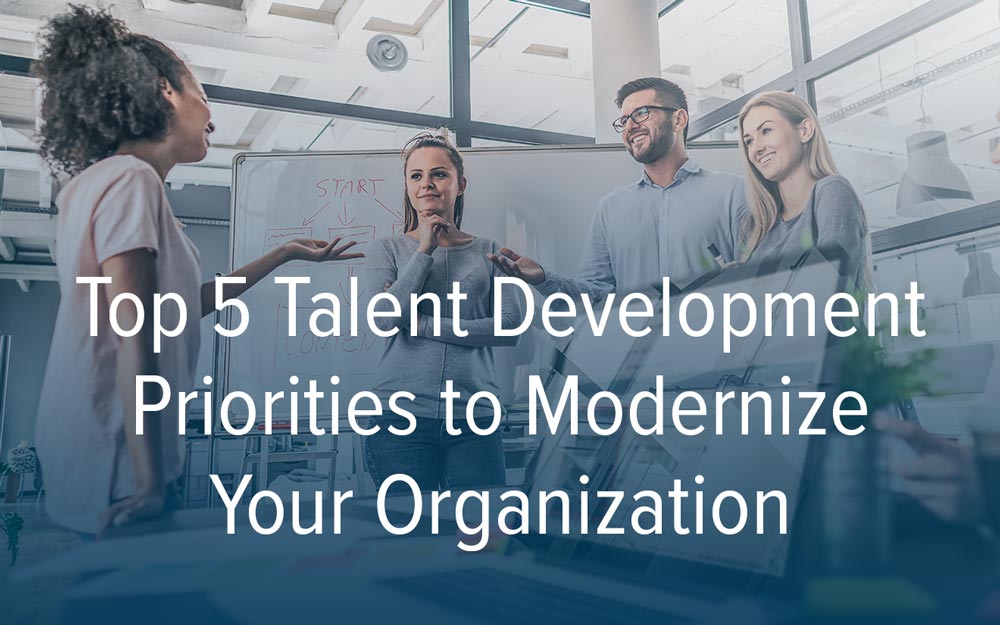
It’s an exciting, yet anxious time in the world of learning and development. Suddenly, it may seem like your organization is lagging behind the increasingly steep talent development curve. To keep up with the pace of business, L&D professionals, HR, and management are working to navigate best courses of action. It’s time to respond to the “Great Reprioritization” with improved talent development strategies and some new priorities of your own.
The marker of success in the new work world will be how well organizations can quickly adapt to rapidly changing environments. Additionally, organizations will rely on well-developed talent to execute these changes. Organizations are already recognizing this need. According to Brandon Hall Group research in 2021, “63% of organizations indicated they would invest moderately or heavily in improving the alignment between talent strategy and business goals.”
So, where do you start? First, organizations must understand how to nurture and maximize employees’ potential. Next, organizations must set talent development priorities that best align the needs of employees and the business.
The Great Reprioritization
The “Great Reprioritization” movement is about employees rediscovering their values and recognizing their potential, underscored by a general gap between employee desires and career opportunities. According to The University of Phoenix’s Annual Career Optimism Index 2022:
- 68 percent of workers say they would stay with their employer throughout their career if they had opportunities to upskill
- 65 percent of workers said they would stay throughout their career if their employer made an effort to reskill them.
- 49 percent of employees want to develop their skills but don’t know where to begin — this is up 6 percentage points compared to 2021 — and 66 percent of employers believe the same
The Great Reprioritization isn’t only about meeting employees’ needs – it’s about shifting business perspectives to support sustainable growth. By investing in talent development, organizations respond to this movement with finesse. Define priorities in the context of the new normal.
Talent development planning/strategy
The hardest part of change is change management. Companies are facing barriers in their efforts to skill their employees, but with the help of L&D professionals and the guidance of a unified plan, organizations can eliminate some of these challenges. By narrowing focus and setting goals, change becomes less daunting. Here are some actionable priorities to guide your talent development plan and set your organization on track.
Your top talent development priorities:
1. Make onboarding seamless and effective
Employee turnover and ineffective onboarding is time consuming and costly. By implementing an effective onboarding solution, companies can set the tone for seamless workflow and promote organizational values.
For example, in this Amplifire case study, a call center invested in improving their onboarding process and found that an effective eLearning solution transformed their employee performance and morale. Well-trained employees were more confident and had higher job performance metrics than their previous onboarding strategy.
2. Create a learning culture with a growth mindset
There is a strong link between learning culture and success, which is why it is so important to create a learning culture and growth mindset among your people. Benefits include attracting and retaining top talent, competitive advantage, increased productivity and more.
3. Determine development needs related to business goals
The first part of this is identifying employee knowledge gaps to measure employee competencies. These gaps can inform the baseline for training.
The second part is identifying the gap between competency and where you want to be. This gap will inform the training and/or teaching that will empower your organization to reach its goals.
The third part of this equation is to align development needs with employee aspirations. Harness your people’s desire to level up and grow.
4. Embed learning in workflow
Incorporate learning opportunities in the workflow. Continuous learning boosts employee engagement. Engaged employees are happier and more productive – and more likely to stay. As much of the workforce is leaning virtual, a technical solution is necessary to power continuous learning. With an adaptive learning solution that can support virtual and hybrid instruction, employers can better engage their people.
5. Offer training aimed at inclusion
As reported by the Society for Human Resource Management, senior vice president of people strategy at Hired, Samantha Lawrence, predicts, “Companies that will double down on their DE&I efforts and successfully leverage best practices to expand their talent pipeline will not only deliver on the public DE&I commitments they made in 2019 and 2020, but also attract and retain top talent.” Offering comprehensive training to eliminate bias and misinformation is a great way to tackle this initiative.
A note on leveraging technology
It goes without saying that many of these priorities are made possible by leveraging technology. With effective tools, such as eLearning solutions, L&D professionals can harness data and insights into the effectiveness of these priorities. They can also refine and optimize talent development processes as time goes on. Aligning with the new work world will require ongoing effort – and leveraging tech makes it manageable.
Amplifire’s goal is to support businesses looking to gain an edge in the modern age by offering an adaptive learning solution that supports employee learning, training, and growth. Learn more about how we can enrich talent development at your organization.







